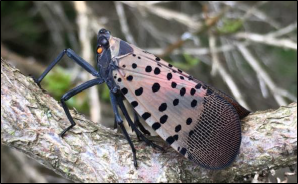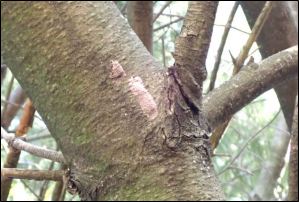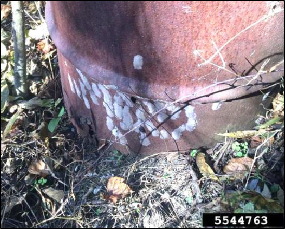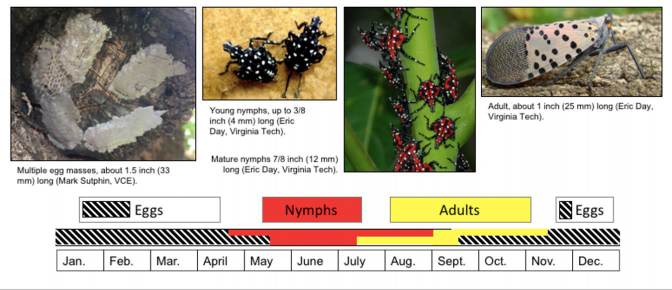Best Management Practices for Spotted Lanternfly on Christmas Tree Farms
ID
ENTO-402NP
Introduction
The Spotted Lanternfly (SLF) is not a pest of conifers, but the movement of Christmas trees may accidentally spread SLF. A Christmas tree with SLF egg masses could be taken to an un-infested area and then discarded outdoors after the holiday season. If nymphs hatch from those egg masses in the spring, a new population of SLF could establish at that site. Egg masses laid on non-living objects could be moved as well. The active, mobile stages of SLF are also opportunistic hitchhikers during the warmer months, and their accidental transfer from one area to another is another concern.
SLF (Fig. 1) is a serious pest of grapes and other crops. SLF is not considered a direct threat to conifers such as Christmas trees as it prefers a wide range of deciduous trees and plants. However, many of these preferred host plants can be found on and around Christmas tree farms.

While SLF might not feed on Christmas trees, the females lay their egg masses on many tree species, including conifers (Fig. 2). They also lay egg masses on agricultural equipment, vehicles, trailers, tools, pallets, structures, fencing, decorative items, and just about anything left outside from September until cold weather kills the adults (Fig. 3). SLF overwinters as these egg masses and hatch as young nymphs in the spring.
There is a slight risk that fresh Christmas trees may harbor SLF egg masses. Customers can be reassured that should an egg mass hatch in the home, the nymphs will not survive inside due to the heat and lack of moisture in the air. SLF nymphs found indoors can be killed easily by physical crushing, drowning in soapy water, placing in hand sanitizer, or with an aerosol insecticide. In the unlikely event that a SLF egg mass or nymph is found on a Christmas tree, the homeowner should contact the local Cooperative Extension office to report the find.


The Virginia Department of Agriculture and Consumer Services (VDACS) encourages all agricultural producers to do their part to watch for SLF and avoid human-assisted transportation of this pest across the state. Every Christmas tree farm operating in or near the quarantine area or any known infested areas should take precautions to prevent moving SLF.
SLF Awareness
All workers on a Christmas tree farm should be aware of SLF. Knowledge of the SLF life cycle, including when the various life stages can be expected throughout the year, is key to monitoring for SLF. Workers should be instructed on what to do if SLF is found in any life stage. Understanding and following the SLF quarantine set by VDACS is very important to limiting the spread of SLF in Virginia and other states.
A calendar of the SLF lifecycle will help you look for the appropriate life stage of SLF at the proper time of the year (Fig. 4). Share this information with your workers before tree cutting begins. Workers should know how to recognize SLF egg masses on tree trunks and non-living objects such as vehicles, equipment, fencing, decorative items, and similar items. If egg masses are found, they are easily destroyed by crushing and scraping them. Shaking cut trees should dislodge any adult SLF that may be present if temperatures have remained warm, but it will not dislodge any egg masses.
Christmas tree farms that have extended agritourism seasons (such as produce stands, farm markets, pumpkin patches, corn mazes, festivals and events, other attractions, etc.) should be vigilant throughout the year if operating when any of the mobile stages of SLF occur. Visitors may accidentally bring SLF to your farm, or may accidently transport SLF from your farm back to their home. Even at wholesale tree farms that do not have visitors on site, SLF can be introduced or spread by the movement of equipment, vehicles, supplies, etc. on and off the farm.
SLF Quarantine in Virginia
Currently the official SLF quarantine includes the City of Winchester and Frederick County. SLF Permits are required for all businesses inside the quarantine area. SLF is also known to infest Clarke County, which is not under a quarantine. In addition, there are small, isolated populations of SLF in Shenandoah, Warren, and Augusta Counties. Citizens and businesses located outside but near the official quarantine area or other known, infested areas are strongly encouraged to follow the SLF quarantine guidelines as well. Updates on the SLF distribution and quarantine in Virginia can be found on the VDACS Plant Industry website under the section labeled “Spotted Lanternfly (Lycorma delicatula) — A Serious Threat to Virginia’s Agriculture” (https://www.vdacs.virginia.gov/plant-industry-services.shtml).
All plants, plant parts, and plant materials are regulated by the quarantine. This includes any fresh Christmas trees, wreaths made with fresh greenery, and any decorative items made with logs or branches. It would also include any other plants or plant materials that may be sold through agritourism, such as potted plants, produce, pumpkins, corn shocks, etc.
Whether a farm offers choose-and-cut, pre-cut, or ball-and-burlap live trees, all Christmas trees in the quarantine area or near it should be inspected for SLF before they leave the farm. Ball-and-burlap live trees should be closely examined to ensure that no egg masses are hidden in the folds of the burlap.

Inspecting the trees complies with the SLF quarantine and reassures customers that their tree is safe to take home. If egg masses are found, they are easily destroyed by crushing and scraping the mass.
The quarantine also regulates the movement of items that may have SLF on them. This includes vehicles, lawn mowers, agricultural equipment, trailers, tarps, fencing, pallets, storage containers, and any furniture, equipment, or items stored outside. Items not specifically mentioned here can include anything that could potentially transport SLF in any life stage. Moving these items could result in the transport of SLF. More information about the SLF quarantine is available through VDACS, or at https://bit.ly/35UegTD.
Requirements and Recommendations for Christmas Tree Operations Inside the Quarantine Area
For operations located in the City of Winchester and Frederick County: if trees or plant materials are sold on site and will remain inside the quarantine zone, there are no restrictions on their movement. The Spotted Lanternfly Permit is not required for sales that remain within the quarantine area, but inspecting regulated materials is always a good idea. If the customer will be taking a tree out of the quarantine area, then an inspection is required on site. Under the quarantine, inspections for SLF are the responsibility of the business selling the commodity.
Growers located inside the quarantine area who are shipping Christmas trees or moving any regulated item out of the quarantine area must have a Spotted Lanternfly Permit. The items must be inspected and verified that they are free of all stages of SLF. Also, a copy of the Spotted Lanternfly Permit and a completed inspection statement must be sent with the regulated items. To obtain a Spotted Lanternfly Permit in Virginia, take the online course for the Training Credential and apply to VDACS for a Spotted Lanternfly Permit. To start this process, visit https://ext.vt.edu/agriculture/commercial-horticulture/spotted-lanternfly.html and click on the link to Spotted Lanternfly Quarantine Training. Other states may have their own quarantines for SLF and their own SLF permitting system, but with reciprocal agreements for the Spotted Lanternfly Permit from Virginia.
Recommendations for Christmas Tree Operations Outside the Quarantine Area but Near Recognized SLF Populations
Growers in northern Virginia with operations located outside of Frederick County should remain vigilant for SLF on their farms. For example, Clarke County has established SLF populations but it has not been quarantined by VDACS at the time of this printing.
Visitors from infested areas could accidently bring SLF to the property, or SLF could arrive on plant material, equipment, vehicles, trailers, or other items brought in from infested areas. Growers are highly encouraged to inspect trees and other plant materials before they leave the farm as a means of monitoring for SLF populations and indicating to customers that SLF is a serious pest that requires attention.
There are no restrictions on the movement of plants or plant materials that may harbor SLF outside the quarantine zone, but you should be aware of SLF and report any insects you suspect are SLF.
From January 1 through March 31, there are no restrictions on the intrastate shipping of regulated materials originating from a location outside of the quarantine area but traveling through the quarantine area. From April 1 through December 31, a business may move any regulated materials that originate outside of the quarantine area through the quarantine area as long as: 1) the regulated materials are accompanied with a waybill indicating the point of origin for the items; 2) the shipment moves directly through the quarantine area without stopping, except for refueling or due to traffic conditions OR if the regulated materials have been stored, packed, or handled in a manner as not posing a risk of infestation; and 3) the regulated materials have not been combined or commingled with other articles so as to lose their individual identity.
Recommendations for Christmas Tree Operations Outside the Quarantine and Known Infested Areas
Growers outside of northern Virginia should remain vigilant for SLF on their farms even if located away from infested areas. There are no restrictions on the movement of regulated materials outside the quarantine zone, but you should be aware of SLF and report insects you suspect are SLF. Visitors from infested areas could accidently bring SLF to your property, or it could arrive on plant material, equipment, vehicles, trailers, or other items brought in from infested areas.
What to Do if You Find SLF?
No matter if your Christmas tree operation is located inside the quarantine area, within a known infested area, or where SLF has not been found previously, always kill SLF whenever possible. If SLF has not been found on your property previously, please preserve any nymphs or adults you find in hand sanitizer, rubbing alcohol, or by freezing. If possible, take a clearly focused, closeup photo of any egg masses before destroying them by scraping or crushing. Report your find by contacting your local Virginia Cooperative Extension Office. Clear, close- up photos can be submitted to https://ask.extension.org/groups/1981/ask. Keep your preserved specimen and photos to document your find with Cooperative Extension. Reports from growers are an important tool for VDACS to track the movement of SLF, even if you are located within the quarantine area.
If you find SLF outside of the quarantine area, it is very important that you follow the steps above and report your find. Reporting any life stage of SLF found outside of the quarantine area is an important step in documenting previously unknown populations of this pest.
Virginia Cooperative Extension materials are available for public use, reprint, or citation without further permission, provided the use includes credit to the author and to Virginia Cooperative Extension, Virginia Tech, and Virginia State University.
Virginia Cooperative Extension is a partnership of Virginia Tech, Virginia State University, the U.S. Department of Agriculture (USDA), and local governments, and is an equal opportunity employer. For the full non-discrimination statement, please visit ext.vt.edu/accessibility.
Publication Date
February 15, 2021



